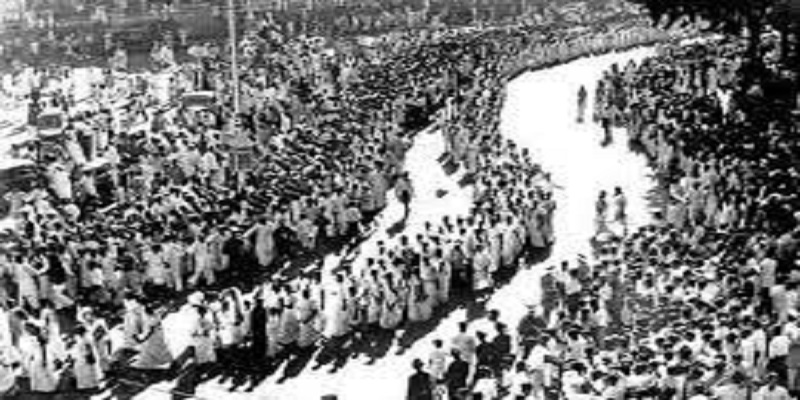The Pivotal Quit India Movement of 1942
The Quit India Movement, also known as the August Movement or the August Kranti, was a pivotal moment in the Indian independence movement against British colonial rule. This movement, initiated by Mahatma Gandhi, aimed at securing an immediate end to British rule in India. The Quit India Movement unfolded against the backdrop of World War II, as India sought to take advantage of Britain's vulnerabilities during the global conflict.
Historical Context:
By 1942, the Indian subcontinent was deeply enmeshed in the turmoil of World War II. The war had drained the British Empire's resources, and the global political landscape was shifting. In this context, Indian nationalists saw an opportunity to intensify their struggle for independence. The British government, however, was reluctant to grant India self-rule, leading to mounting discontent among Indian leaders and the public.
Causes of the Quit India Movement:
Several factors contributed to the intensification of the independence movement and the eventual call for the Quit India Movement:
- Failure of Cripps Mission: The failure of the Cripps Mission in 1942 was a turning point. The mission, led by Sir Stafford Cripps, proposed limited dominion status for India after the war, but it was rejected by both the Indian National Congress and the Muslim League.
- Economic Exploitation: The economic exploitation of India for the war effort without any commensurate political concessions fueled resentment. Indians were heavily taxed, and the wartime shortages exacerbated the economic hardships faced by the common people.
- Repression of Civil Liberties: The British government's repressive measures and curtailment of civil liberties further alienated Indian leaders. The introduction of the Defense of India Rules and the arbitrary arrests of nationalist leaders heightened the discontent.
- Influence of Mahatma Gandhi: Mahatma Gandhi's leadership and commitment to non-violence played a crucial role. He believed that a non-violent mass struggle could compel the British to leave India.
Launch of the Quit India Movement:
On August 8, 1942, the All India Congress Committee, under the guidance of Mahatma Gandhi, passed the Quit India resolution in Bombay. The resolution demanded the immediate withdrawal of British forces from India and the establishment of a democratic government.
In his famous "Do or Die" speech, Gandhi called upon the Indian people to launch a mass struggle. The call was for non-violent civil disobedience, and the objective was to paralyze the government machinery. The slogan "Quit India" echoed across the country as people from all walks of life joined the movement.
Response and Repression:
The response to the Quit India Movement was overwhelming, with millions of Indians participating in protests, strikes, and acts of civil disobedience. The movement witnessed the active involvement of students, peasants, workers, and women.
However, the British government responded with harsh repression. The government arrested prominent leaders, including Mahatma Gandhi, Jawaharlal Nehru, Sardar Patel, and Maulana Abul Kalam Azad. The police and military were given orders to suppress the protests, leading to violent clashes in various parts of the country.
Despite the repression, the Quit India Movement marked a significant shift in the dynamics of the Indian independence movement. The mass participation and the resilience of the people demonstrated the depth of the demand for freedom.
Impact and Legacy:
- International Attention: The Quit India Movement garnered international attention and sympathy for the Indian cause. The global community, already critical of colonialism, viewed the British response to the movement unfavorably.
- Weakening of British Authority: The movement weakened the British government's authority in India. The British were forced to reassess their position, realizing that continued colonial rule was unsustainable in the face of widespread opposition.
- Post-War Changes: The conclusion of World War II marked a shift in global power dynamics. The weakened state of Britain and the rise of the United States and the Soviet Union influenced the post-war political landscape. This shift played a role in Britain's decision to grant independence to India in 1947.
- Empowerment of the Masses: The Quit India Movement empowered the masses and instilled a sense of self-confidence among the people. The realization that a united, non-violent struggle could challenge the mighty British Empire laid the foundation for future movements and ultimately contributed to India's independence.
- Contribution to Constitution: The ideals of the Quit India Movement, particularly the emphasis on democracy, justice, and equality, found expression in the framing of the Indian Constitution after independence.
The Quit India Movement of 1942 was a watershed moment in India's struggle for independence. It not only exposed the vulnerabilities of British rule but also showcased the power of non-violent mass movements. The legacy of the Quit India Movement resonates in India's history as a symbol of the people's determination to break free from colonial shackles and assert their right to self-determination.

